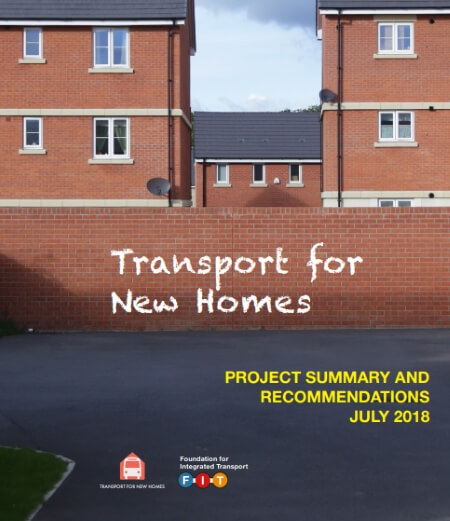"Aspirations for new homes mirror many aspects of modern society thinking. This envisages more physically active and less isolated lives, reduced congestion on the roads, whilst at the same time promoting a low carbon future. But what are we really building? Which new developments live up to our expectations? Are there some places that have got it right?"

A report based on studies of transport provision and associated lifestyles in new housing developments in England was published in July 2018 by the Transport for New Homes project.
The main thrust of the findings is that most of the schemes that were looked at were creating high levels of car dependency while also exacerbating congestion, were difficult to integrate into public transport networks and were not condusive to walking as a means of transport. The researchers found that this was in marked contrast to how new developments are planned and implemented in the Netherlands.
While the problems outlined are generally less acute in London, if only because our public transport is so much better than elsewhere in England, I think that all the issues examined in the report are relevant, especially now when we are drawing up a new Enfield Local Plan, in which the predominant focus is on where to build new housing. Meridian Water potentially offers an opportunity to do things the right way for once, but only if the council is closely involved in the design of the new streets throughout the process and doesn't leave too much to individual developers, who will naturally concentrate on their own narrower priorities.
It's a while since I read through the draft local plan and I've forgotten most of the detail, and we now have less than ten days to comment. One thing that I'll be looking for is to see to what extent Meridian Water will be self-sufficient, by which I mean work as a town, with its own places of employment, its own shops (not huge supermarkets) and its own pubs, cafes, restaurants, places of worship and entertainment, so that people can live full lives without travelling elsewhere. But when they do go elsewhere, they should be able to get there on foot, by bike or by bus without having to contend with a particularly horrible section of the North Circular Road.
Another theme that emerges from the study is that small brownfield sites can be much more easily integrated into public transport networks and walking routes than larger greenfield developments - somethign that will please the amenity societies that are concerned about possible incursion into the Green Belt.
One comment that I'll be making on the draft local plan, is that the committee and officers working on it should read this report (it's quite short) and perhaps get in touch with the researchers.
Recommendations of the report
- Develop a national framework setting out where to build new homes, based on provision of sustainable transport, and aiming to meet economic, social and environmental needs.
- Build new housing in existing large urban areas, or in places that are close to, and well connected by public transport, walking and cycling.
- Plan land use and transport together. Local authorities must be able to work cross-boundary to analyse, design and fund public transport in tandem with the expansion of a whole area.
- Invest urgently in urban and suburban public transport to serve expanding satellite towns and new suburbs. Local authorities wanting new rail stations and services face a mountain of barriers – these need to be addressed and overcome. Where appropriate, fund trams and light rail as means to pull expanding areas together. Put serious money into capital and revenue support for bus infrastructure and services to enable the new residents to beat the traffic using the bus.
- Use urban brownfield and regeneration sites. New urban quarters benefit from existing public transport networks and can be reached on foot and by cycle. Relate targets for new homes to the potential of redevelopment and brownfield sites.
- Plan for higher densities but less area wasted on parking. Build modern apartments and town houses with wide appeal, including near stations, with shops underneath and leisure facilities on site as, for instance, in Basingstoke, Bath, Bristol, London, Swindon and Woking. Take advantage of the enhanced viability of local businesses and public transport to improve the public realm. Curtail car parking to allow our planners to design more attractive places with more space for greenery and better public realm.
- Look more closely at the lessons from Poundbury. The architecture and ‘olde world’ feel of Poundbury may not be popular with everyone, but it seems to be successful as an urban extension. The new town is built at a human scale around walking not cars, and employment and retail are integrated into the walking environment. An interesting public realm with limited car parking contributes to its social success, economic viability and attraction for a variety of people and age groups. Planning policy must reflect the lessons from Poundbury – how it has achieved such success and its advantages and disadvantages as a model for other urban extensions.



